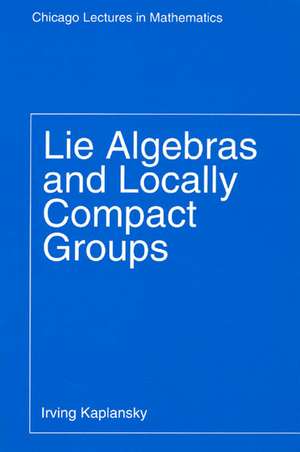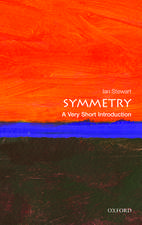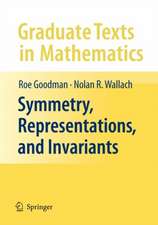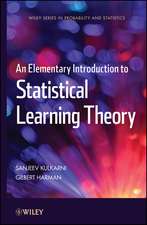Lie Algebras and Locally Compact Groups: Chicago Lectures in Mathematics
Autor Irving Kaplanskyen Limba Engleză Paperback – 31 dec 1970
This volume presents lecture notes based on the author's courses on Lie algebras and the solution of Hilbert's fifth problem. In chapter 1, "Lie Algebras," the structure theory of semi-simple Lie algebras in characteristic zero is presented, following the ideas of Killing and Cartan. Chapter 2, "The Structure of Locally Compact Groups," deals with the solution of Hilbert's fifth problem given by Gleason, Montgomery, and Zipplin in 1952.
Din seria Chicago Lectures in Mathematics
- 8%
 Preț: 463.43 lei
Preț: 463.43 lei -
 Preț: 281.14 lei
Preț: 281.14 lei -
 Preț: 227.15 lei
Preț: 227.15 lei -
 Preț: 279.93 lei
Preț: 279.93 lei -
 Preț: 380.31 lei
Preț: 380.31 lei -
 Preț: 260.69 lei
Preț: 260.69 lei - 27%
 Preț: 858.13 lei
Preț: 858.13 lei -
 Preț: 311.17 lei
Preț: 311.17 lei -
 Preț: 290.55 lei
Preț: 290.55 lei -
 Preț: 265.69 lei
Preț: 265.69 lei -
 Preț: 331.00 lei
Preț: 331.00 lei -
 Preț: 252.55 lei
Preț: 252.55 lei -
 Preț: 259.37 lei
Preț: 259.37 lei -
 Preț: 375.29 lei
Preț: 375.29 lei - 15%
 Preț: 193.91 lei
Preț: 193.91 lei - 20%
 Preț: 159.55 lei
Preț: 159.55 lei - 14%
 Preț: 299.04 lei
Preț: 299.04 lei - 31%
 Preț: 120.47 lei
Preț: 120.47 lei
Preț: 374.70 lei
Nou
Puncte Express: 562
Preț estimativ în valută:
71.71€ • 77.86$ • 60.23£
71.71€ • 77.86$ • 60.23£
Carte tipărită la comandă
Livrare economică 22 aprilie-06 mai
Preluare comenzi: 021 569.72.76
Specificații
ISBN-13: 9780226424538
ISBN-10: 0226424537
Pagini: 155
Dimensiuni: 133 x 203 x 20 mm
Greutate: 0.19 kg
Editura: University of Chicago Press
Colecția University of Chicago Press
Seria Chicago Lectures in Mathematics
ISBN-10: 0226424537
Pagini: 155
Dimensiuni: 133 x 203 x 20 mm
Greutate: 0.19 kg
Editura: University of Chicago Press
Colecția University of Chicago Press
Seria Chicago Lectures in Mathematics
Notă biografică
Irving Kaplansky is Director Emeritus of the Mathematical Sciences Research Institute and George Herbert Mead Distinguished Professor Emeritus in the Department of Mathematics at the University of Chicago.
Cuprins
PREFACE
Chapter I. LIE ALGEBRAS
1. Definitions and examples
2. Solvable and nilpotent algebras
3. Semi-simple algebras
4. Cartan subalgebras
5. Transition to a geometric problem
(characteristic 0)
6. The geometric classification
7. Transition to a geometric problem
(characteristic p)
8. Transition to a geometric problem
(characteristic p), continued
Chapter II. THE STRUCTURE OF LOCALLY COMPACT GROUPS
1. NSS groups
2. Existence of one-parameter subgroups
3. Differentiable functions
4. Functions constructed from a single Q
5. Functions constructed from a sequence of Q's
6. Proof that i/n. is bounded
7. Existence of proper differentiable functions
8. The vector space of one-parameter subgroups
9. Proof that K is a neighborhood of 1
10. Approximation by NSS groups
11. Further developments
BIBLIOGRAPHY
INDEX
Chapter I. LIE ALGEBRAS
1. Definitions and examples
2. Solvable and nilpotent algebras
3. Semi-simple algebras
4. Cartan subalgebras
5. Transition to a geometric problem
(characteristic 0)
6. The geometric classification
7. Transition to a geometric problem
(characteristic p)
8. Transition to a geometric problem
(characteristic p), continued
Chapter II. THE STRUCTURE OF LOCALLY COMPACT GROUPS
1. NSS groups
2. Existence of one-parameter subgroups
3. Differentiable functions
4. Functions constructed from a single Q
5. Functions constructed from a sequence of Q's
6. Proof that i/n. is bounded
7. Existence of proper differentiable functions
8. The vector space of one-parameter subgroups
9. Proof that K is a neighborhood of 1
10. Approximation by NSS groups
11. Further developments
BIBLIOGRAPHY
INDEX

















